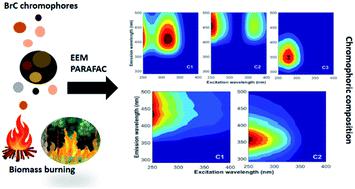当前位置:
X-MOL 学术
›
Environ. Sci.: Processes Impacts
›
论文详情
Our official English website, www.x-mol.net, welcomes your
feedback! (Note: you will need to create a separate account there.)
Brown carbon aerosols in the Indo-Gangetic Plain outflow: insights from excitation emission matrix (EEM) fluorescence spectroscopy
Environmental Science: Processes & Impacts ( IF 4.3 ) Pub Date : 2021-4-9 , DOI: 10.1039/d1em00050k Supriya Dey 1, 2, 3, 4 , Arya Mukherjee 2, 3, 4, 5 , Anuraag J. Polana 1, 2, 3, 4 , Archita Rana 1, 2, 3, 4 , Jingying Mao 6, 7, 8, 9 , Shiguo Jia 9, 10, 11, 12, 13 , Amit K. Yadav 4, 14, 15, 16 , Pandit. S. Khillare 4, 14, 15, 16 , Sayantan Sarkar 1, 2, 3, 4, 17
Environmental Science: Processes & Impacts ( IF 4.3 ) Pub Date : 2021-4-9 , DOI: 10.1039/d1em00050k Supriya Dey 1, 2, 3, 4 , Arya Mukherjee 2, 3, 4, 5 , Anuraag J. Polana 1, 2, 3, 4 , Archita Rana 1, 2, 3, 4 , Jingying Mao 6, 7, 8, 9 , Shiguo Jia 9, 10, 11, 12, 13 , Amit K. Yadav 4, 14, 15, 16 , Pandit. S. Khillare 4, 14, 15, 16 , Sayantan Sarkar 1, 2, 3, 4, 17
Affiliation

|
We report the first characterization of the aerosol brown carbon (BrC) composition in the Indian context using excitation emission matrix (EEM) fluorescence spectroscopy coupled with parallel factor (PARAFAC) analysis. We find that biomass burning (BB)-dominated wintertime aerosols in the Indo-Gangetic Plain (IGP) outflow are characterized by two humic-like (HULIS) (C1_aq and C2_aq) and one protein-like/fossil fuel-derived (C3_aq) component for aqueous-extractable BrC (BrCaq), and by one humic-like (C1_me) and one protein-like (C2_me) component for methanol-extractable BrC (BrCme). Strong correlations of the BB tracer nss-K+ with C1_aq and C2_aq (r = 0.75–0.84, p < 0.01) and C1_me (r = 0.77, p < 0.01) point towards the BB-dominated IGP outflow as the major source. This is also supported by the analysis of fluorescence indices, which suggest extensive humification of BB emissions during atmospheric transport. The HULIS components correlate significantly with BrC absorption (r = 0.85–0.94, p < 0.01), and contribute substantially to the BrC relative radiative forcing of 13–24% vis-à-vis elemental carbon (EC). There is strong evidence that the abundant BB-derived NOX leads to NO3− formation in the IGP plume and drives the formation of water-soluble nitroaromatics (NACs) that constrain BrCaq light absorption (r = 0.56, p < 0.01) to a considerable degree. Overall, the study uncovers complex atmospheric processing of the IGP outflow in winter, which has important implications for regional climate.
中文翻译:

印度恒河平原流出物中的褐碳气溶胶:激发发射矩阵(EEM)荧光光谱学的见解
我们报告使用激发发射矩阵(EEM)荧光光谱结合并行因子(PARAFAC)分析在印度上下文中气溶胶棕碳(BrC)成分的首次表征。我们发现印度洋-恒河平原(IGP)流出物中以生物质燃烧(BB)为主导的冬季气溶胶的特征是两种腐殖质样(HULIS)(C1_aq和C2_aq)和一种蛋白质样/化石燃料衍生的(C3_aq)用于水萃取的BrC(BrC aq)的组分,以及用于甲醇萃取的BrC(BrC me)的一种腐殖质样(C1_me)和一种蛋白质样(C2_me)组分。BB示踪剂nss-K +与C1_aq和C2_aq(r = 0.75–0.84,p <0.01)和C1_me(r= 0.77,p <0.01)指向以BB为主的IGP流出作为主要来源。荧光指数分析也支持了这一点,该分析表明在大气运输过程中BB排放物被大量腐化。HULIS组分与BrC吸收显着相关(r = 0.85-0.94,p <0.01),并且对BrC相对于元素碳(EC)的13-24%的相对辐射强迫有很大贡献。有强有力的证据表明丰富BB衍生NO X导致NO 3 -的形成在IGP羽流和驱动器的水溶性硝基芳族化合物(顾问委员会)的形成该限制BRC AQ光吸收([R = 0.56,p <0.01)。总体而言,该研究揭示了冬季IGP流出的复杂大气过程,这对区域气候具有重要意义。
更新日期:2021-04-26
中文翻译:

印度恒河平原流出物中的褐碳气溶胶:激发发射矩阵(EEM)荧光光谱学的见解
我们报告使用激发发射矩阵(EEM)荧光光谱结合并行因子(PARAFAC)分析在印度上下文中气溶胶棕碳(BrC)成分的首次表征。我们发现印度洋-恒河平原(IGP)流出物中以生物质燃烧(BB)为主导的冬季气溶胶的特征是两种腐殖质样(HULIS)(C1_aq和C2_aq)和一种蛋白质样/化石燃料衍生的(C3_aq)用于水萃取的BrC(BrC aq)的组分,以及用于甲醇萃取的BrC(BrC me)的一种腐殖质样(C1_me)和一种蛋白质样(C2_me)组分。BB示踪剂nss-K +与C1_aq和C2_aq(r = 0.75–0.84,p <0.01)和C1_me(r= 0.77,p <0.01)指向以BB为主的IGP流出作为主要来源。荧光指数分析也支持了这一点,该分析表明在大气运输过程中BB排放物被大量腐化。HULIS组分与BrC吸收显着相关(r = 0.85-0.94,p <0.01),并且对BrC相对于元素碳(EC)的13-24%的相对辐射强迫有很大贡献。有强有力的证据表明丰富BB衍生NO X导致NO 3 -的形成在IGP羽流和驱动器的水溶性硝基芳族化合物(顾问委员会)的形成该限制BRC AQ光吸收([R = 0.56,p <0.01)。总体而言,该研究揭示了冬季IGP流出的复杂大气过程,这对区域气候具有重要意义。











































 京公网安备 11010802027423号
京公网安备 11010802027423号